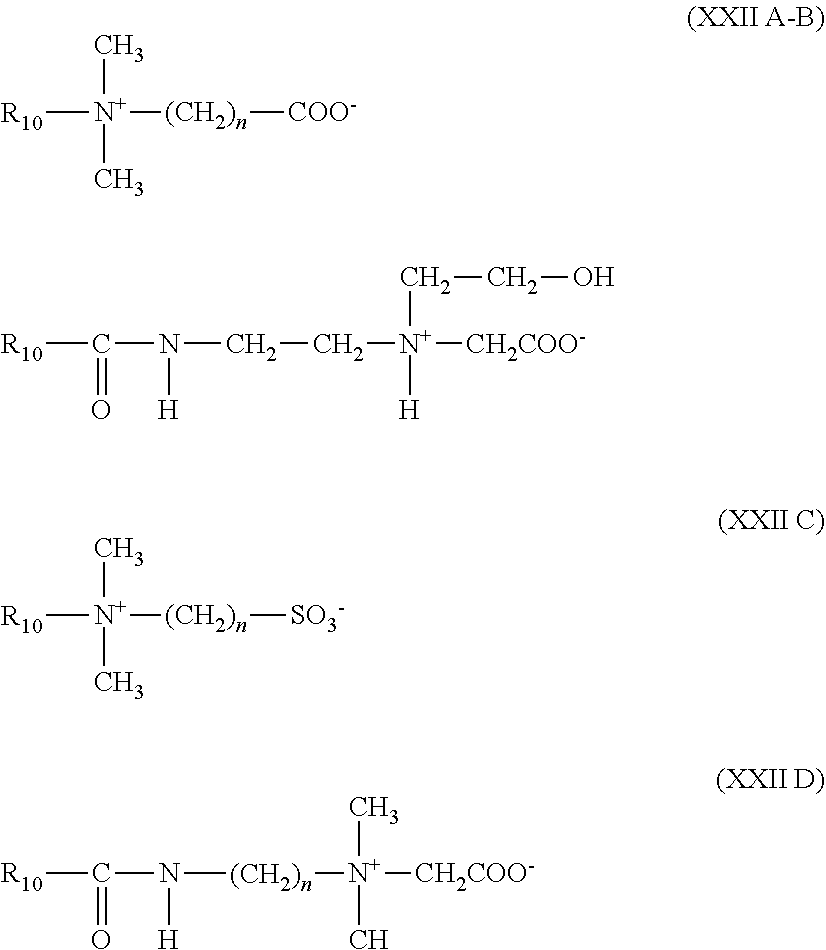Gentle cleanser compositions
a technology of compositions and cleansers, applied in detergent compositions, make-up, detergent compounding agents, etc., can solve the problems of affecting the appearance of skin, so as to achieve the effect of removing make-up from the skin, and reducing the volume of foam
- Summary
- Abstract
- Description
- Claims
- Application Information
AI Technical Summary
Benefits of technology
Problems solved by technology
Method used
Image
Examples
example 1
Example and Comparative Examples
[0114]
TABLE 1Cleanser CompositionsClaimINCI USInventiveInventiveComparativeComparativeComparativeComparativecomponentNAMEExample 1Example 2Example 1Example 2Example 3Example 4(a)Sodium Methyl333333Cocoyl Taurate(e)C12-15 alkyl lactate1.21.21.21.21.21.2(d)Coco-Betaine5.45.45.45.45.45.4(b)Salicylic Acid222222(c)Kaolin220102030(f)Rheology Modifier1.51.51.51.51.51.5Propylene glycol (and)0.1PEG-55 PropyleneGlycol OleatePreservatives, pH1-51-51-51-51-51-5adjuster, co-solvents,polymers, fillers andfragrancesWaterQ.SQ.S.Q.SQ.SQ.SQ.S
[0115]The Inventive and Comparative Examples in Table 1 were prepared according to the procedure as follows: the main kettle was heated to 70 C. Once the temperature was reached, 90% of water was added to the main kettle, as well as preservatives, solvent, salicylic acid, pH adjuster, emulsifier, and C12-15 alkyl lactate. The ingredients were side sweep at medium speed. A side phase containing Citric Acid and 10% of total water at ...
example 2
bility Test
[0121]The purpose of the Zein Solubility Test is to investigate the irritation potential (harshness) of a surfactant-based product. A high percent Zein Score represents irritation and harshness. A low percent Zein Score represents mildness and lack of irritation. Zein is a yellow corn protein that is similar to the keratin present in skin. It has limited solubility in water and is denatured (solubilized) by surfactants. The ability of surfactants to denature and solubilize zein has been linked to a surfactant's skin-irritation potential. The soluble zein protein is determined by utilizing a standard protein assay which measures protein absorbance values using a spectrophotometer. The amount of absorption correlates with the harshness of the product. The samples were tested and the results reported relative to a 1.5% solution of sodium laureate sulfate (SLS), as a positive control. The Zein Scores are expressed in terms of percentage of the SLS Zein Score. The measured mil...
example 3
n of the Clay
[0124]Different types of clay were evaluated. The different clays were incorporated in formulas at a same percentage. The mildness and the salicylic deposition were measured and are presented in the Table 4 below.
[0125]
TABLE 4Evaluation of Different type of ClaysSalicylic AcidDeposition Avg.ExamplesType of ClaysZein %Residual ugInventive2% Kaolin1.46%23.11ugexample 2Comparative2% Magnesium1.10%20.7ugexample 5Aluminum SilicateComparative2% Moroccan Lava1.74%15.91ugexample 6Clay
[0126]From the results above, it is shown that the deposition of salicylic acid depends on the type of clay. The deposition of salicylic acid is equal to 23.11 ug in the case of the inventive example 1 containing 2% of kaolin. In the case of the comparative examples 5 and 6 containing 2% Magnesium Aluminum Silicate and 2% Moroccan Lava Clay, respectively, the deposition of salicylic acid is lower and equal to 20.7 ug in the formula containing 2% Magnesium Aluminum Silicate (comparative example 5) a...
PUM
| Property | Measurement | Unit |
|---|---|---|
| wt. % | aaaaa | aaaaa |
| wt. % | aaaaa | aaaaa |
| composition | aaaaa | aaaaa |
Abstract
Description
Claims
Application Information
 Login to View More
Login to View More - R&D
- Intellectual Property
- Life Sciences
- Materials
- Tech Scout
- Unparalleled Data Quality
- Higher Quality Content
- 60% Fewer Hallucinations
Browse by: Latest US Patents, China's latest patents, Technical Efficacy Thesaurus, Application Domain, Technology Topic, Popular Technical Reports.
© 2025 PatSnap. All rights reserved.Legal|Privacy policy|Modern Slavery Act Transparency Statement|Sitemap|About US| Contact US: help@patsnap.com



